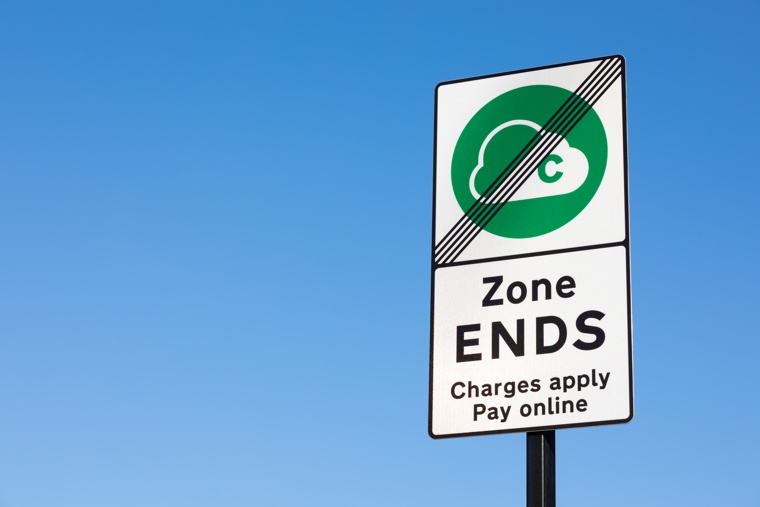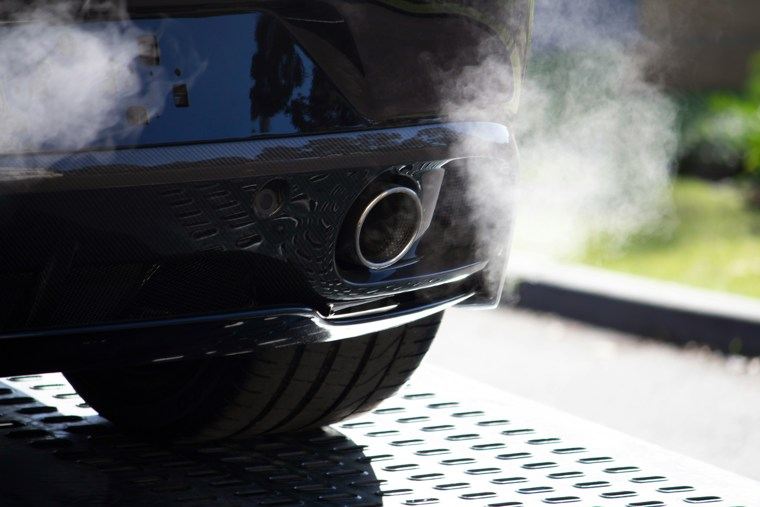
As cities across the UK take bold steps to combat urban pollution, the introduction of Clean Air Zones (CAZs) is set to have a profound impact on our daily lives. These zones, designed to reduce emissions in city centres, are not just about cleaner air; they're about promoting healthier communities, safeguarding our environment, and encouraging sustainable travel choices.
Whether you're a daily commuter, a business owner, or someone concerned about the air quality in your neighbourhood, the roll-out of CAZs is something you need to be aware of. Each month in the UK there are 52,000 Google searches around ‘Clean air zones’ as Brits look for guidance on the newly announced areas around the country and what they need to do if travelling through one.
In this blog post, Nationwide Vehicle Contracts aims to demystify the concept of Clean Air Zones, explaining what they are, where they're being implemented, and most importantly, what you need to do to comply with these new rules. From the specifics of vehicle emissions standards to the potential charges for non-compliance, we offer guidance on:
Clean Air Zones are specifically designated areas within cities where the government imposes restrictions on vehicle access. They have been introduced as part of government plans to improve air quality and limit what vehicles can access certain areas in designated cities. The idea is to encourage individuals and businesses to upgrade to cleaner, more environmentally friendly vehicles, such as electric cars or hybrids, or to use alternative modes of transportation like public transit, cycling, or walking.
Within a Clean Air Zone, vehicles are assessed based on their emission standards. The focus is on the most polluting vehicles, including older diesel and petrol models that do not meet specific emission criteria. These criteria are typically based on Euro standards – Euro 6 for diesel vehicles and Euro 4 for petrol vehicles. Any vehicle that does not meet the minimum emissions will have to pay a charge for entering the area.
The UK has four different classes of clean air zones, each targeting different types of vehicles. For car owners, Class D zones are of particular importance, as these areas impose charges on the broadest range of vehicles, including private cars, unless they meet specified emissions standards.
Class | Vehicle type | Description |
|---|---|---|
A | Buses, coaches, taxis, private hire vehicles. | This class is primarily aimed at reducing emissions from high-usage, older public transport and commercial transport vehicles that contribute significantly to urban air pollution |
B | Buses, coaches, taxis, private hire vehicles, heavy goods vehicles. | Expands upon Class A by also including heavy goods vehicles (HGVs). This class addresses larger vehicles that have a substantial impact on air quality due to their size and diesel engines, which are known for emitting higher levels of pollutants. |
C | Buses, coaches, taxis, private hire vehicles, heavy goods vehicles, vans, minibuses. | Further extends the range of targeted vehicles to include vans and minibuses, in addition to those covered in Classes A and B. This class recognises the role of smaller commercial and passenger vehicles in contributing to traffic congestion and pollution within urban areas. |
D | Buses, coaches, taxis, private hire vehicles, heavy goods vehicles, vans, minibuses, cars, the local authority has the option to include motorcycles. | The most comprehensive category, impacting all vehicle types covered in Classes A, B, and C, with the addition of private cars. Local authorities also have the discretion to include motorcycles in this class. Class D zones are designed to encourage a widespread shift towards cleaner transportation methods by applying charges to the most common types of vehicles on the road, including those used for personal transport. |
For car drivers, navigating through or around Class D Clean Air Zones requires careful consideration. Charges apply daily, meaning each day a non-compliant vehicle enters the zone, a new charge is incurred. The criteria for compliance typically align with the vehicle's fuel type and emission standards—specifically, Euro 6 for diesel vehicles and Euro 4 for petrol vehicles. Cars that do not meet these standards will be subject to the CAZ charge.

The UK's commitment to improving air quality and reducing vehicle emissions has led to the introduction of Clean Air Zones (CAZs) in several cities. These zones are categorized into different classes (B, C, and D), each targeting specific vehicle types. Understanding which cities have implemented each class of CAZ can help drivers prepare for potential charges and consider cleaner transportation options.
- Portsmouth: As a Class B CAZ, Portsmouth targets buses, coaches, taxis, private hire vehicles, and heavy goods vehicles (HGVs). The zone is part of the city's strategy to tackle nitrogen dioxide levels exceeding legal limits. Drivers of non-compliant vehicles are required to pay a daily charge to drive within the zone, aiming to encourage the use of cleaner, less polluting vehicles.
- Bath: Bath's Class C CAZ includes buses, coaches, taxis, private hire vehicles, HGVs, vans, and minibuses. The goal is to reduce harmful emissions in the city centre, making Bath a healthier place to live and visit. Charges are applied to non-compliant commercial vehicles, but private cars are currently exempt.
- Bradford: Similar to Bath, Bradford's Class C CAZ targets a broad range of vehicles, excluding private cars. The focus is on encouraging the use of cleaner commercial vehicles to improve air quality in the city.
- Sheffield: Sheffield's CAZ encompasses the same vehicle categories as Bath and Bradford. As a class C chargeable zone for the most polluting heavy goods vehicles, private cars will not be charged. It's part of the city's wider efforts to reduce pollution and protect public health by incentivizing the transition to greener transportation modes.
- Tyneside (Newcastle and Gateshead): The Tyneside area has introduced a Class C CAZ covering Newcastle and Gateshead, targeting high-emission commercial vehicles to significantly reduce pollution levels across both cities.
- Birmingham: Birmingham's Class D CAZ is among the most comprehensive, including all vehicle types covered in Classes B and C, plus private cars. The zone aims to drastically cut down on pollution by encouraging the use of vehicles that meet strict emission standards, including electric and hybrid models. If you live in Birmingham you need to check your car emissions before you travel through the clean air zones in the city centre to ensure you aren’t charged the fee.
- Bristol: Bristol has also opted for a Class D CAZ, applying charges to the same wide range of vehicles as Birmingham. This initiative is part of Bristol's ambitious plan to improve air quality and meet environmental targets by reducing the number of polluting vehicles in the city centre.
For residents and visitors to these cities, understanding the specific CAZ class and its requirements is crucial. Each city has its own set of rules, exemptions, and charges, designed to address local air quality challenges. Drivers are encouraged to check their vehicle's compliance before travelling to or through these zones to avoid unexpected charges. Many cities offer online tools to help drivers determine if their vehicle meets the required emission standards for entering a CAZ without incurring a charge.
As the UK continues to prioritize environmental health and sustainability, more cities are expected to introduce or expand their Clean Air Zones. This evolving landscape underscores the importance of staying informed about local regulations and considering cleaner, more sustainable transportation options for the future.
“If you currently live in a busy city, there has never been a better time to consider an electric or low-emission car, as you will not only benefit from avoiding costly emission charges, but your vehicle will also be compliant with any future city plans.”

To navigate Clean Air Zones without incurring charges, it's crucial to know the emission standards your vehicle must meet. For cars, the minimum requirements are typically Euro 6 for diesel engines and Euro 4 for petrol engines. These standards are part of a Europe-wide regulation aimed at reducing harmful pollutants from vehicles.
- Vehicle Handbook: The easiest way to check your vehicle's emission standard is to look in your car's handbook. The manufacturer usually lists the Euro standard compliance in the specifications section.
- Online Vehicle Checkers: Many local authorities and environmental agencies offer online tools where you can enter your vehicle's registration number to check its emissions standard. These tools can instantly tell you if your vehicle is compliant with the CAZ requirements.
- VIN Number: The Vehicle Identification Number (VIN) can also provide emission standard information. Manufacturers often encode this information, and various online tools can decode it for you.
The charges for entering a CAZ with a non-compliant vehicle vary depending on the city and the type of vehicle. This flexible charging structure is designed to reflect the economic and environmental priorities of each specific area. Vehicle owners must pay the charge within 7 days of entering the zone to avoid additional penalties.
- Charge Amount: The daily charge amount varies by CAZ class and location. For example, charges in a Class D zone, which includes private cars, can differ significantly from those in Class B or C zones, which may not affect private car drivers. Charges are determined by local authorities and reflect the environmental and economic priorities of each area.
- Payment Window: Typically, drivers have a grace period of 7 days from the date of entry into a CAZ to pay the charge. Failure to pay within this period can result in additional fines and penalties.
- Frequency of Charges: Charges are applied on a daily basis. If your vehicle enters the CAZ multiple times in a day, you are only charged once. However, each new day your vehicle enters the zone triggers another charge.
To facilitate compliance, local authorities typically offer a range of services, including online tools to check if your vehicle meets the CAZ emission standards and payment portals for easy charge settlement. These include:
- Online Tools: Most local authorities offer online platforms where drivers can check if their route passes through a CAZ and calculate any charges they may incur. These tools often require you to input your vehicle's registration number to determine compliance with emission standards.
- Payment Methods: Payments can typically be made online through the official website of the local authority managing the CAZ. Some areas may offer additional payment options, such as phone lines or physical payment centres.
- Financial Assistance: Some local authorities provide financial support to help drivers upgrade non-compliant vehicles.
Several groups may be eligible for exemptions or discounts from CAZ charges, including:
- Residents: People living within a CAZ may qualify for a temporary exemption or reduced charges to ease the transition.
- Special Vehicles: Vehicles used for disabled passengers, historic vehicles, and emergency services are often exempt.
Whether you're considering an upgrade to an electric vehicle or just curious about your current car's impact, it's time to take action. Visit the official vehicle checker to see if your vehicle meets the required emissions standards and dive into our comprehensive guide on the benefits of electric and low-emission vehicles. Don't let charges catch you by surprise—be informed, be prepared, and drive towards a cleaner future today.
